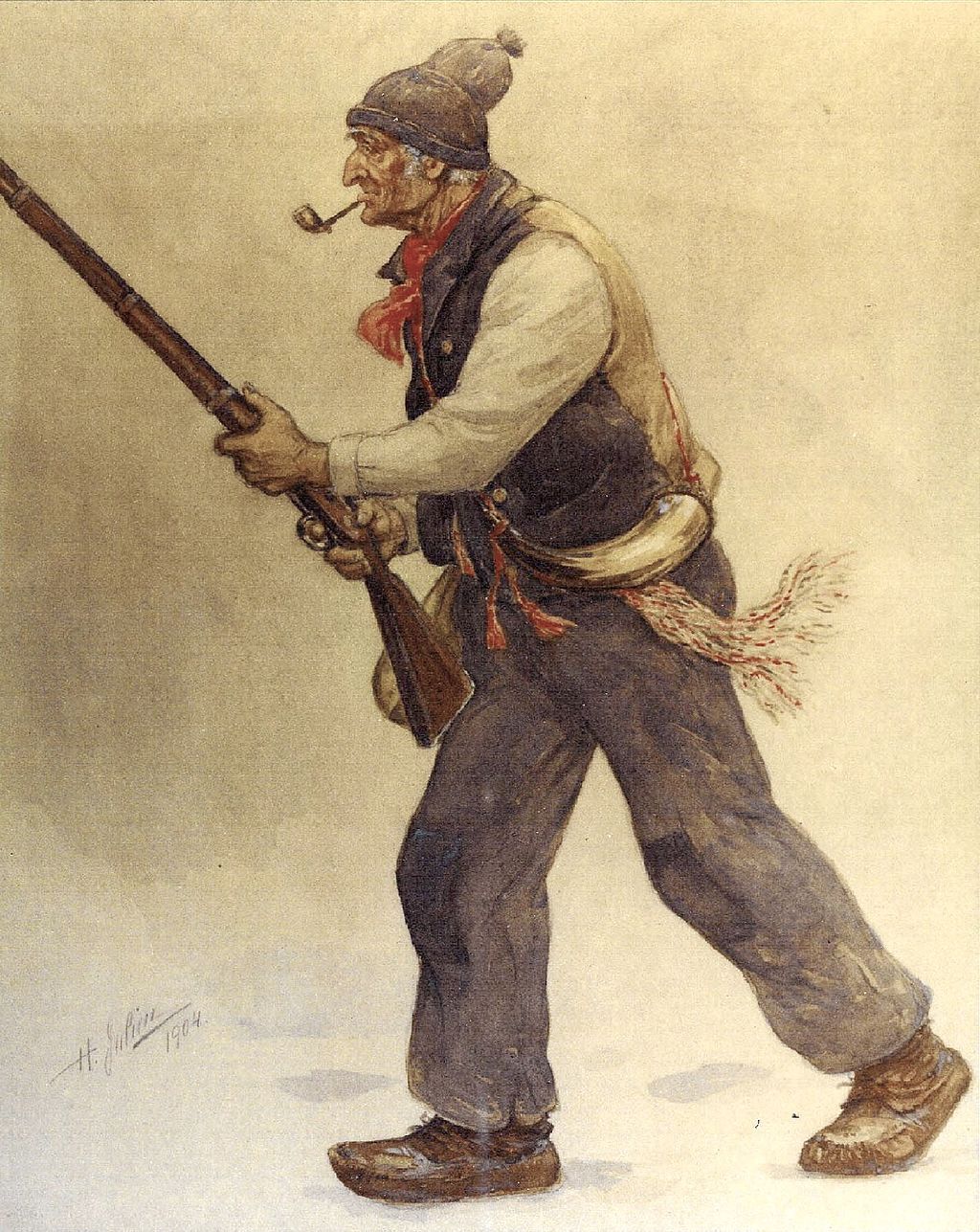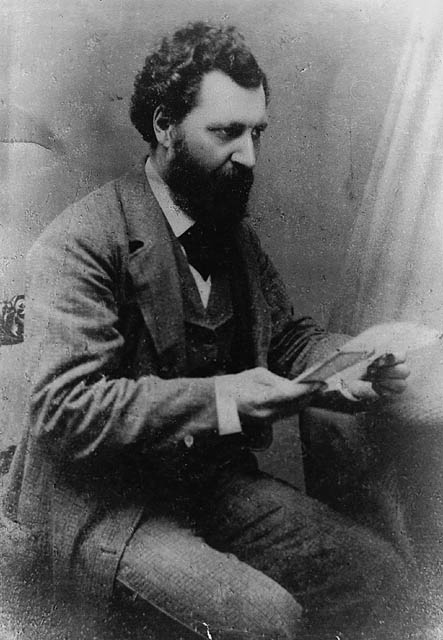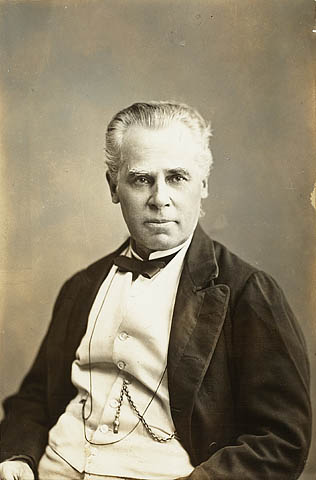Sir George-Étienne Cartier, co-premier of the Province of Canada, lawyer, railway promoter, politician (born 6 September 1814 in Saint-Antoine, Lower Canada; died 20 May 1873 in London, England). Sir George-Étienne Cartier dominated the politics of Quebec for a generation. After rebelling against the government in the Rebellions of 1837–38, Cartier served as Canada’s first minister of militia and defence. Arguably the kingpin of Confederation, he was responsible for bringing French Canada, Manitoba and British Columbia into the Dominion. He also negotiated the purchase of Rupert’s Land and the North-West Territories from the Hudson’s Bay Company. He is considered a Father of Confederation.
Education and Early Career
George-Étienne Cartier was from a wealthy family of grain exporters and millers. According to family legend, they were descendants of the family of Jacques Cartier.
A graduate of the Sulpician Collège de Montréal, Cartier was called to the bar in 1835. He then joined the radical Fils de la Liberté (Sons of Liberty), to fight against the Château Clique. He composed the patriotic song “Ô Canada! mon pays! mes amours!” It was perhaps the model for the later national anthem, “O Canada.” He was also secretary of the Saint-Jean-Baptiste Society in 1843.
The Rebellions of 1837-38
In 1837, Cartier fought bravely alongside Wolfred Nelson and the rebels at the Battle of St-Denis. They successfully routed Colonel Charles Gore’s force of British regulars. (See Rebellion in Lower Canada.) After a narrow escape, Cartier lived in exile in Vermont.
In 1838, he successfully petitioned to return and practice law in Montreal. Among his clients were the Sulpician Order, the original seigneurs of Montreal, and the St. Lawrence and Atlantic Railway.

Political Career
Cartier soon became active in politics. In 1841, he became Louis-Hippolyte LaFontaine’s campaign manager and right-hand man. The two were dedicated to reforming the Civil Code and restoring the Assembly of the Province of Lower Canada; French Canadians held a majority, but it had been nullified by the Act of Union in 1840. With responsible government won in 1848, Cartier ran and was elected as a Liberal Reformer in Verchères. He was soon brought into Cabinet.
Cartier moved to Montreal East in 1861 after the coalition with the Conservatives of Canada West (formerly Upper Canada). As head of Parti bleu, he served as co-premier with John A. Macdonald in the Union parliaments of 1857–58 and 1858–62. One of his main achievements in this period was getting Queen Victoria to choose Ottawa as the capital of the Canadas in 1857. His reasoning was that Ottawa was more defensible militarily than Toronto, Kingston, Montreal or Quebec City. It was on the boundary between the two provinces of the Union. It was also on the route of the planned railway to the north-west and the Pacific, which would make Montreal the colony’s main centre in a continental trading system.

Confederation
In the years leading up to Confederation, Cartier and his large block of supporters from Canada East (formerly Lower Canada) allied with Macdonald’s smaller cohort of Conservatives from Canada West (Upper Canada). This created political deadlock in the Province of Canada. They finally convinced George Brown and his supporters to join the Great Coalition of 1864. With this in place, they worked toward a wider union of the provinces of British North America (BNA).
In the conferences that followed, Cartier’s goal was to ensure that Canada became a federation of provinces rather than a single legislative union like Britain. At the Charlottetown Conference in 1864, Cartier made the case for a great confederation of all the BNA colonies. He inspired the Maritime delegates with a promise to build the Intercolonial Railway. At the Quebec Conference, Cartier argued for the creation of a new “political nationality.” He denounced Parti rouge leader A.A. Dorion’s contention that French Canada would be better off joining the United States. Cartier stated that French interests could be preserved under the proposed Confederation.
At Confederation, Cartier chose the militia ministry. His aim was to build up a national force strong enough to resist any invasion or interference from the United States. A strong military was also key to securing the entry of the north-west into Confederation.
The West
In the first years of Confederation, Cartier often served as acting Prime Minister during Macdonald’s illnesses. He played a key role in securing Rupert’s Land (1869) and in drafting the Manitoba Act (1870) and the British Columbia Act (1871).
In 1868–69, he and William McDougall negotiated in London for the transfer of the HBC territory of Rupert’s Land and the North-West Territories to the Dominion. Cartier had close relations with British railway builders, military officials and financiers. This made him fully in tune with imperial interests regarding an “All-Red Route” to the Pacific and Asia through Canada’s huge new territory. McDougall was appointed lieutenant-governor of the area. However, he was prevented from entering by Louis Riel and his men. (See Red River Resistance.)
Manitoba
Cartier may have met Louis Riel. Both had been educated at the Sulpician Collège de Montréal, although not at the same time. Cartier sympathized with the Métis. He played a key role in negotiating their acceptance of provincehood through their emissary, Abbé Ritchot. After passage of the Manitoba Act on 12 May 1870, Cartier sent Adams Archibald and many of his own hand-picked men to oversee the new province.

British Columbia
Cartier welcomed British Columbia delegates John Sebastian Helmcken, Joseph Trutch and Robert Carrall to Ottawa in June 1870. He promised them a transcontinental railway if British Columbia joined Confederation. (The delegates had planned only to ask for a wagon road east.) Cartier negotiated the Terms of Union with British Columbia, which were passed in 1871.
The Transcontinental Railway
Cartier promoted the development of rail throughout his career. He was heavily involved in the development of the Grand Trunk Railway and served as its solicitor. He was also chairman of the Railway Committee of Parliament in the Union government.
Cartier was also a driving force in the early promotion of the Canadian Pacific Railway (CPR). This sealed the bargain with British Columbia and made Montreal the terminus of a transcontinental trading network.
However, Cartier’s plans were opposed by rival railway promoters in Boston and Philadelphia. They wanted to tap into the trade of the Canadian north-west by railway lines crossing the border. These promoters financed Cartier’s political rival in Montréal East, Louis-Amable Jetté of the short-lived Parti national. This led to Cartier’s defeat in 1872. Louis Riel quickly offered to resign his own seat in Manitoba, and Cartier soon became the MP for Saint Boniface. The American promoters then engineered the release in April 1873 of election fundraising telegrams — the so-called Pacific Scandal — while heavily subsidizing their own Canadian supporters.
Cartier’s letters had promised to consider awarding Sir Hugh Allan the railway contract. But Cartier was already mortally ill with Bright’s disease when the scandal erupted. He died soon after seeking treatment in London. Afterwards, the CPR languished for almost a decade.

Legacy
Cartier was the chief voice of the French Canadian community, the pivotal group in the union. As such, he was the kingpin of the Confederation movement. He masterfully made use of his block votes and his railway and militia interests to create a new union and a new nationality. He reconciled the majority of French Canada to Confederation on the grounds that it prevented annexation by the United States. It also made possible the end of the Union government and the restoration of the old Province of Quebec.
See also Quebec and Confederation; Fathers of Confederation; Confederation Timeline; Confederation Collection.

 Share on Facebook
Share on Facebook Share on X
Share on X Share by Email
Share by Email Share on Google Classroom
Share on Google Classroom





